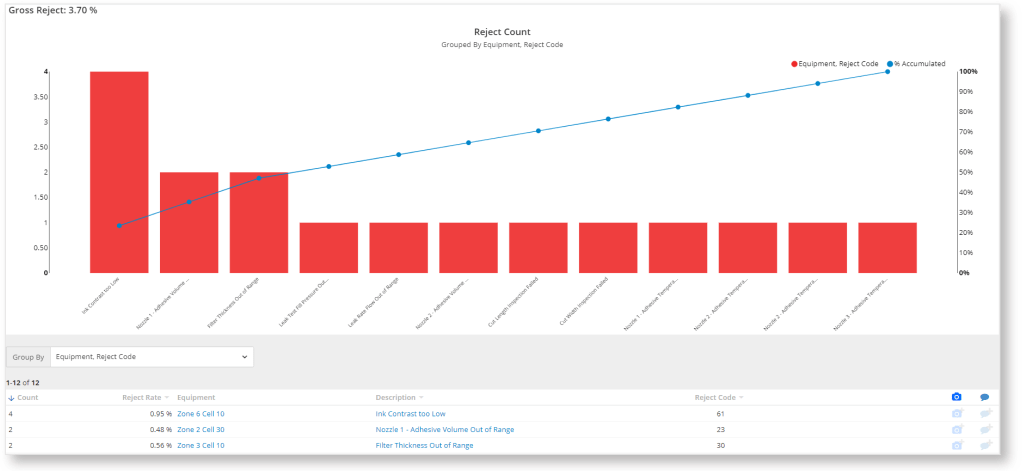“Manufacturers invest in minimizing or eliminating the yield loss they experience because at the end of the day every rejected product or lot is simply a loss of dollars. The fiscal impact is different depending on the industry but between the material, time, labor, energy, and opportunity wasted when product produced is discarded the monetary loss experienced is often significant” – Greg Sullivan, ATS Digital Solutions Specialist
Manufacturers monitor several key performance metrics to determine how manufacturing operations are performing. One such metric is yield loss, the amount of product produced that is rejected or defective or otherwise discarded as a percentage of the total number of products produced. High yield loss rates can put significant financial strain on a manufacturing operation. The collection and analysis of operational data can help manufacturers minimize the yield loss they experience, increase throughput, and improve their bottom line.
Why should manufacturers care about their yield loss rate?
Regardless of the industry, product, or process, when talking about manufacturing operations discarded products are nothing but a negative. Whether you are talking about the raw material, energy, man hours, or opportunity cost, the manufacturer incurs a measurable reduction in economic return each time product is discarded during its production.
Manufacturing yield loss rate also represents unnecessary wear on equipment and consumable parts as total throughput is raised to meet production goals, thereby reducing expected operating lifetime of equipment, and increasing maintenance costs.
Yield losses can also impact a manufacturer’s ability to meet production targets, which can have an impact on customer relationships and competitiveness. This is especially true for contract manufacturers which face stiff penalties for failing to fulfil contractual obligations.
Taken together, yield losses experienced by manufacturers also have negative impacts on society and the environment. Discarded products and components end up disposed of in landfills or released into the environment. This includes toxic materials like lubricants and heavy metals (e.g., batteries). Wasted raw-materials and energy, depleted non-renewable resources and excess pollution.
How can manufacturers reduce yield loss?
Once a manufacturer has collected their operational data, they can begin to break down the lost output they experience and determine how much lost output can be attributed to quality loss versus performance loss or availability loss.
This process enables a manufacturer to determine their quality yield, the number of good parts produced as a percentage of total throughput as well as their yield loss. After determining their yield loss, a manufacturer will have to perform a deep analysis of the manufacturing data available to understand where within the process the defect is occurring and why. Once they understand the where and the why, a manufacturer can develop solutions and data driven changes to their manufacturing process to eliminate or significantly reduce the amount of yield loss they were experiencing. Understanding where the defects are occurring, and the underlying root causes enables manufacturers to make calculated decisions instead of guessing or “shooting in the dark”.
The quality of the analysis is determined in large part by the quality and characteristics of the data they are able to collect. If a manufacturer has access to data that possesses a high level of granularity and reliability, they will be better equipped to accurately determine the root causes of the yield losses they are experiencing. The employment of an IoT (Internet of Things) platform responsible for the collection and organization of manufacturing data is widely considered as the optimal method for collecting the highest quality of manufacturing data and enabling manufacturers to develop effective solutions and process changes.
Employing an IoT platform for data collection and analysis can reduce the man hours dedicated to data collection and increase the speed at which it can be done. Organizations employing an IoT platform can expect increased granularity and accuracy in their data because the potential room for human error is minimized (in many cases eliminated), greater storage capacities enable the ability to work with larger sample sizes of data, and the access to station and cell level data that traditional methods of data collection do not typically offer.
How manufacturers can acquire the high-quality data they need to minimize the yield loss they experience
Illuminate ™ Manufacturing Intelligence, an industry 4.0 smart manufacturing system developed and produced by ATS Automated Tooling Systems, is an example of an IoT platform used by manufactures to collect and analyze production performance data.
Take the example of a Class II medical device manufacturer, that was experiencing significant yield losses. Defective products were being produced and progressing further through the manufacturing process, causing additional material, energy, and time to be wasted, thereby contributing to a high overall yield loss rate. The data collected by their Illuminate ™ Manufacturing Intelligence implementation enabled them to develop and implement improvements to an inspection station preventing defective parts to move further down the manufacturing process. The solution significantly reduced the total amount of yield loss that the organization was experiencing.

Closing Thoughts
Output loss is expensive. Through the employment of IoT-enabled solutions, manufacturing organizations can collect high quality, real-time data that contains the necessary characteristics to enable effective root-cause analysis and calculated changes that reduce the amount of defective products produced. Making use of these modern tools instead of manually collecting and manipulating data from the plant floor allows for faster, more accurate reporting that allows teams to react quickly and arrive at data-driven solutions. An organization that is able to minimize their yield loss rate will have a greater opportunity to maximize production capacities and eliminate costs, resulting in a positive impact on their bottom line.
Learn more about Illuminate™ Manufacturing Intelligence: https://illuminatemi.com/solutions/
Learn more about ATS Automated Tooling Systems: https://atsautomation.com/

